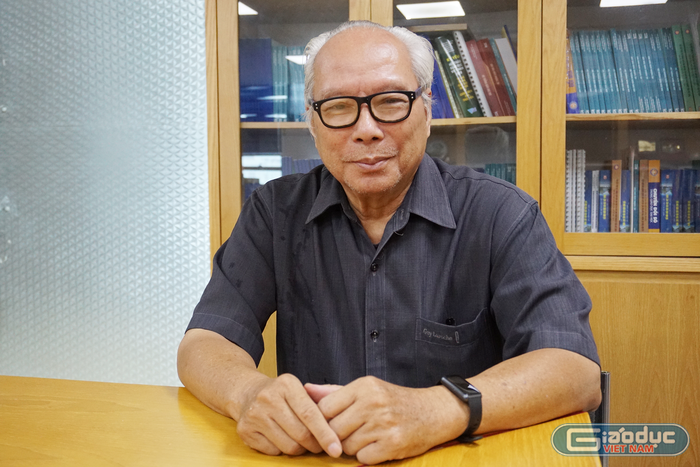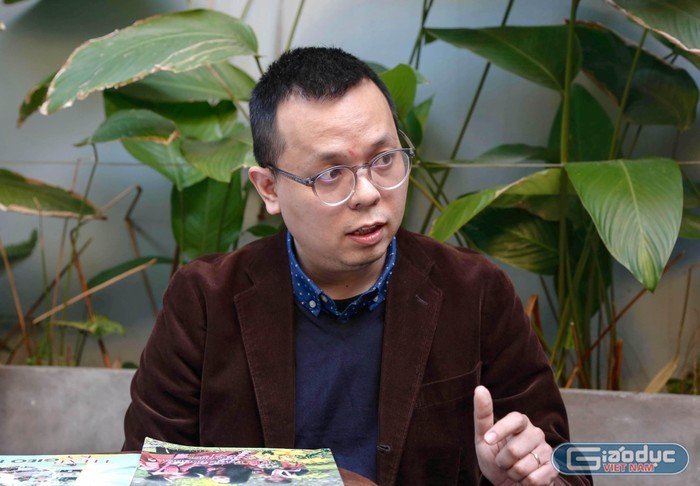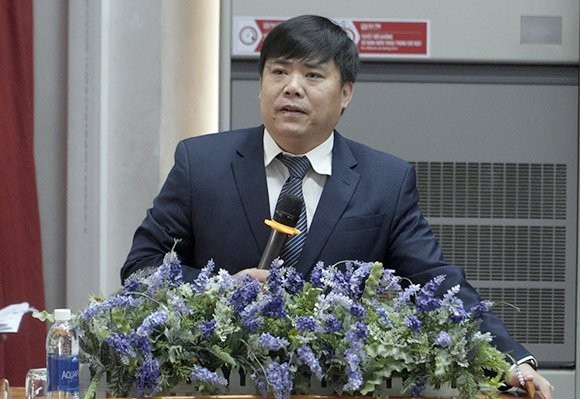According to experts, the target of having 260 university students per ten thousand people by 2030 is reasonab...
According to experts, the target of having 260 university students per ten thousand people by 2030 is reasonable and entirely achievable.
According to many experts, Vietnam's university enrollment rate is still low compared to other countries in the region and internationally. To successfully implement the country's industrialization and modernization goals, the university enrollment rate must be increased.
Resolution No. 81/2023/QH15 of the National Assembly dated January 9, 2023, also set the target for 2030, with the university student ratio reaching 260 per ten thousand people.
Currently, Vietnam's university enrollment rate is still low.
In an exchange with the electronic magazine "Vietnam Education," Dr. Le Viet Khuyen, former Deputy Director of the Department of Higher Education (Ministry of Education and Training), currently Vice President of the Association of Vietnamese Universities and Colleges, stated that setting the target of having 260 university students per ten thousand people by 2030 is appropriate.
 Le Viet Khuyen - Vice President of the Association of Vietnam Universities and Colleges. Photo: PM
Le Viet Khuyen - Vice President of the Association of Vietnam Universities and Colleges. Photo: PM
According to the classification recognized today, when the university enrollment rate is below 15%, the education system of that country is considered to be in the elite stage – mainly training scholars and some experts.
Furthermore, when this rate is between 15-50%, university education transitions to the mass stage; exceeding 50% is the universal stage, meaning education is not only for scholars but also includes a large workforce of experts, technicians, and skilled workers.
To develop the economy, implement industrialization, modernize the country, and enter the fourth industrial revolution, Vietnam needs to focus on increasing the university enrollment rate.
The scale of university education needs to continue to expand, but at the same time, the step-by-step roadmap must be appropriate to the country's realities.
University educational institutions should base their enrollment scale and vocational structure decisions on data on the employment needs of various sectors to ensure suitability.
Additionally, it is necessary to effectively connect high school programs with career guidance and admissions for students to choose appropriate educational levels and serve the labor needs of society.
Sharing his views on this issue, Dr. Pham Hiep, Head of the Reduvation Education Innovation Research Group at Thanh Do University, stated that previously, in 2005, Resolution No. 14/2005/NQ-CP issued by the Government set the target of "achieving a ratio of 450 students per ten thousand people by 2020."
However, due to many objective and subjective factors, we have not achieved the task of expanding our education system.
In 2023, the National Assembly set a more modest target: a university student ratio of 260 per ten thousand people by 2030. In the current context, the country gradually has the infrastructure and potential to achieve this goal.
 Pham Hiep - Head of the Reducation Education Innovation Research Group, Chengdu University. Photo: Ngoc Anh
Pham Hiep - Head of the Reducation Education Innovation Research Group, Chengdu University. Photo: Ngoc Anh
Dr. Pham Hiep also noted that Vietnam's university enrollment rate is still low. According to a report from the World Bank in August 2022, the university and college enrollment rate of Vietnamese students in 2019 was 28.6%, which is low compared to the ASEAN region and only half of the average of 55.1% in middle-income countries.
In an interview, Dr. Vo Thanh Hai, Vice Rector of Duy Tan University, stated that expanding the scale of university education would contribute to the development of our country's economy and society in the current trend.
Especially in the new era, the Fourth Industrial Revolution demands labor force that can absorb new knowledge and possess a certain level of proficiency to meet the requirements of high technology. Consequently, the intellectual level of the entire country will be raised.
In recent years, our country has begun to enter a period of more breakthrough development, and the demand for highly skilled labor is increasing. This guides universities to expand their training scale.
According to Dr. Vo Thanh Hai, by around 2030, our country is entirely capable of achieving the target of 260 students per ten thousand people, and the ratio may even be higher in some major cities.
Balancing between public and private university education systems
Looking at the macro picture, Dr. Vo Thanh Hai mentioned: Since 1994, following Resolution No. 04-NQ/HNTW, the Prime Minister allowed the establishment of the first five private universities in Vietnam. Since then, our country has begun to implement the socialist-oriented market economy policy according to the Party and the State, allowing the private education system to be established and developed.
Currently, in terms of proportion, the number of students attending private universities is only about 17 - 20% of the total training scale nationwide. To effectively work towards the goal of expanding the scale of university education, we need to mobilize social resources and increase the scale of private university education.
 Dr. Vo Thanh Hai - Permanent Vice Rector of Duy Tan University. Photo: School website
Dr. Vo Thanh Hai - Permanent Vice Rector of Duy Tan University. Photo: School website
Specifically, the country is repositioning itself to enhance high-tech agriculture or develop tourism, especially in the Central region, the North Central Coast, and the South Central Coast areas. Consequently, education administrators need to forecast the workforce demand for each sector to train according to priorities and avoid local shortages or surpluses.
Additionally, there has been a decline in student interest in certain fields of basic sciences and engineering over the past three years. This trend could potentially impact the future of the country's industrial production, leading to an oversupply of labor in service and economic sectors while facing a shortage in fields such as basic sciences, agriculture, and aquaculture.
Dr. Pham Hiep suggests that the market is capable of self-regulating and adjusting the structure of academic disciplines according to its laws. However, it requires a combined effort of state-level solutions. For instance, the government needs to regulate admission targets for fields like economics, finance, communication, and information technology within the public education system.
Moreover, for rare fields of study where private institutions lack investment interest, the state should intervene, offering incentives such as tuition support programs to encourage student and parent involvement when they perceive government investment signals. This approach also helps maintain the existence and sustainability of these specialized fields within some public institutions.
According to Dr. Le Viet Khuyen, to increase the scale and improve the quality of higher education, the government needs to increase investment in tertiary education. Despite acknowledging that education is the top national policy, only 0.27% of GDP is allocated to higher education, as per the Ministry of Finance's 2020 data.
Moreover, the labor force training structure must be balanced to generate high labor productivity in a multi-component market economy. This necessitates the development of highly skilled laborers to meet the practical needs of the economy while simultaneously fostering societal intellectual development.
Expanding the scale must be accompanied by maintaining quality. Dr. Pham Hiep notes that while regulations ensuring the quality of tertiary education have brought substantial changes in operational procedures for educational institutions, some limitations persist in terms of formalities, independence in assessment, etc. Nevertheless, Vietnam's higher education direction is gradually meeting international quality standards. If all reports of tertiary institutions were centralized on a common management system overseen by the Ministry of Education and Training, it would enable easier comparison and potentially enhance educational quality further.
Dr. Vo Thanh Hai proposes solutions for implementing the expansion of higher education goals. He suggests that educational institutions should enhance teaching quality, faculty qualifications, and invest in infrastructure to integrate with global technology, providing job opportunities commensurate with social realities.
Regarding admission reforms, institutions should tighten training organization and quality assurance processes to ensure that graduates possess the required competencies for employment and self-employment. Tightening input while relaxing output may lead to neglect in learning and training, which is not in line with global educational trends.
Concerning employment demand, organizations, corporations, and enterprises should establish recruitment connections with educational institutions. When there is cooperation between the state, businesses, and educational institutions, parents and students will perceive more accessible and transparent job opportunities. Consequently, the demand for higher education will increase, and learning opportunities will expand.
On the other hand, we should not differentiate between public and private education issues; each institution has different strengths in each field of study. The state should focus on each education institution's field to enhance its quality effectively.
Agreeing with the above viewpoint, Dr. Pham Hiep also stated: Vietnam is now adopting policies to narrow and tighten the public education system and relying on private institutions to solve budget issues.
Alongside the goal of expanding the scale of university education, minimum training quality standards are also required. To achieve this, we need strong support policies for private education institutions to participate in the national education system.
However, the socialization of education still faces many barriers due to the prejudice of "super-profit." Many private training institutions need to undergo strict scrutiny and meet stringent conditions to open new majors.
Dr. Pham Hiep emphasized that regulations on opening majors and establishing schools in the private sector should be flexible, and reasonable policies (such as requirements for floor area, initial investment capital, etc.) should be in place to facilitate the establishment and development of institutions.
The development strategy of private universities needs strong support from the state not only through investment but also through legal mechanisms.
Discussing further on this issue, Dr. Le Viet Khuyen pointed out: Both public and private institutions contribute to expanding the scale of university education, but it is essential to ensure the quality of training, adhere to the right direction to enhance reputation, and not prioritize profit-making activities. Otherwise, in practice, there may be consequences in terms of quality.
However, society should not differentiate between "public or private" because depending on the capacity of each institution, if developed correctly, the private system can also achieve high-quality education. A prime example is in the United States, where some of the most prestigious and reputable universities belong to the private system.
Reasonable human resource training structure between fields of study
According to Dr. Vo Thanh Hai, in terms of breadth, the goal is to expand the scale of university education, but in terms of depth, it is necessary to consider the planning of training needs in various fields of study.
University education needs to provide career orientation for high school graduates to effectively allocate resources.
Via Vietnam Education